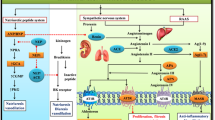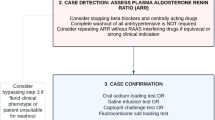Abstract
In their review of clinical practice guidelines on the use of renin-angiotensin-aldosterone system (RAAS) inhibitors, Greenlees and Delles call for more explicit advice on the use of these drugs among women of childbearing potential, during pregnancy and breastfeeding. In response, the British and Irish Hypertension Society (BIHS) highlight the key issues for clinicians to consider when prescribing RAAS inhibitors to hypertensive women and suggest areas where further research is needed.
Similar content being viewed by others
Statement
The National Institute of Health and Care Excellence (NICE) hypertension guideline NG136 recommend renin-angiotensin-aldosterone system (RAAS) inhibitors as first-line antihypertensive treatment in both men and women aged under 55 years (except for those of Black African or African-Caribbean family origin), and those who have type 2 diabetes of any age and family origin. From Step 2 of the NICE treatment algorithm onwards, RAAS inhibitors are recommended to all people with hypertension [1].
The NICE hypertension guideline NG136, supported by the Medicines and Healthcare products Regulatory Agency, caution that angiotensin-converting-enzyme inhibitors (ACE-I) and angiotensin II receptor antagonists (ARB) “should not be used in pregnant or breastfeeding women or women planning pregnancy unless absolutely necessary, in which case the potential risks and benefits should be discussed” [1, 2]. This is based on evidence that RAAS inhibitors are associated with adverse fetal and neonatal outcomes [3, 4].
NICE offers no specific advice on the management of women with unplanned pregnancies while taking RAAS inhibitors.
The UK Teratology Information Service (UKTIS) advise that there is no strong evidence that exposure to ACE inhibitors in the first trimester is associated with congenital malformations in the infant, but a lack of data means that the congenital malformation risk following exposure to ARBs cannot currently be quantified [5, 6]. The UKTIS advises women who have used an ACE-I or ARB in the first trimester, that no extra monitoring for birth defects is required. Women using RAAS inhibitors in the 2nd and 3rd trimester of pregnancy should be closely monitored.
The BIHS believe it is important to open the conversation with clinicians about their use of RAAS inhibitors in hypertensive women of childbearing potential and highlight areas where further research is needed.
The BIHS offer the following advice to clinicians to facilitate conversations with hypertensive women of childbearing potential who are not currently planning a pregnancy or pregnant:
-
Discuss women’s pregnancy plans. For women of childbearing potential who are not actively planning a pregnancy or pregnant, discuss the benefits and risks to the use of RAAS-inhibitors. Support women to make an informed decision. Document conversations.
-
Advise women to use safe and effective contraception while taking RAAS inhibitors.
-
Advise women who take RAAS inhibitors for hypertension to stop these drugs 2–3 months before planning a pregnancy. Consider use of amlodipine or nifedipine or labetalol or methyldopa as alternative antihypertensive drugs, plus folic acid.
-
In the event of contraceptive failure, RAAS inhibitors should be stopped as soon as possible. Further advice and information leaflets can be found at www.uktis.org.
-
A recent study by Kitt and colleagues demonstrated optimising blood pressure (BP) control in the first 2–3 months postpartum after a hypertensive pregnancy, was associated with improved cardiac remodelling [7]. This highlights the importance of establishing good BP control in the immediate postpartum period.
-
There is a lack of robust evidence on both the concentration of RAAS inhibitors in breastmilk and the subsequent effect on newborns. The decision on when to re-introduce RAAS-inhibitors will include elevated maternal BP uncontrolled on other antihypertensive therapies, specific medical and pregnancy history indicating the use of RAAS is critical, and the health and prematurity of the infant [8, 9].
Research questions
-
1.
To quantify the risk of congenital malformation after exposure to RAAS inhibitors in the first trimester of pregnancy.
-
2.
To determine the optimal drug combinations to use during hypertensive pregnancies.
-
3.
To determine the concentration of different antihypertensive drugs in breastmilk and their effect on newborns.
Data availability
All data generated and analysed for the development of this statement are included in this published article.
References
National Institute for Health and Care Excellence. Hypertension in adults: diagnosis and management. NICE guideline [NG136]. Published 28 August 2019, Last updated: 21 November 2023. https://www.nice.org.uk/guidance/ng136.
Medicines and Healthcare products Regulatory Agency. ACE inhibitors and angiotensin II receptor antagonists: not for use in pregnancy. Drug Saf. 2007;1:8.
Hoeltzenbein M, Tissen-Diabaté T, Fietz AK, Zinke S, Kayser A, Meister R, et al. Increased rate of birth defects after first trimester use of angiotensin converting enzyme inhibitors - treatment or hypertension related? An observational cohort study. Pregnancy Hypertens. 2018;13:65–71. https://doi.org/10.1016/j.preghy.2018.04.022.
Ahmed B, Tran DT, Zoega H, Kennedy SE, Jorm LR, Havard A. Maternal and perinatal outcomes associated with the use of renin-angiotensin system (RAS) blockers for chronic hypertension in early pregnancy. Pregnancy Hypertens. 2018;14:156–61. https://doi.org/10.1016/j.preghy.2018.09.010.
UK Teratology Information Service. Use of angiotensin converting enzyme inhibitors in pregnancy. 2021;4. https://uktis.org/monographs/use-of-angiotensin-converting-enzyme-inhibitors-in-pregnancy/.
UK Teratology Information Service. Use of angiotensin II receptor antagonists in pregnancy. 2021;3. https://uktis.org/monographs/use-of-angiotensin-ii-receptor-antagonists-in-pregnancy/.
Kitt J, Krasner S, Barr L, Frost A, Tucker K, Bateman PA, et al. Cardiac remodeling after hypertensive pregnancy following physician-optimized blood pressure self-management: the POP-HT Randomized clinical trial imaging sub-study. Circulation. 2023;149:529–41. https://doi.org/10.1161/circulationaha.123.067597.
Medicines and Healthcare products Regulatory Agency. ACE inhibitors and angiotensin II receptor antagonists: recommendations on how to use for breastfeeding. Drug Saf. 2009;2:3.
Medicines and Healthcare products Regulatory Agency. Clarification: ACE inhibitors and angiotensin II receptor antagonists. Use during breastfeeding. Drug Saf. 2009;2:10a.
Acknowledgements
We would like to thank the following members of the BIHS Guideline Standing Committee and BIHS Executive Committee for their expert review of this manuscript: Professor Adrian J.B. Brady, Professor Phil Chowienczyk, Professor Jacob George, Dr Pankaj Gupta, Dr Andrew Jordan, Dr Vikas Kapil, Dr Spoorthy Kulkarni, Dr Philip Lewis, Professor Terry McCormack, Professor Neil R Poulter, Professor Peter Sever, Dr Wayne Sunman, Dr Helen Warren.
Funding
No financial assistance was received to develop this statement.
Author information
Authors and Affiliations
Contributions
IBW proposed the statement. LF, LA, BJ, ES and IBW provided expert input on the content. SP provided medical writing and editorial support. All authors critically reviewed and approved the final manuscript draft.
Corresponding author
Ethics declarations
Competing interests
Professor Adrian J.B. Brady has received honoraria from Daiichi-Sankyo, Amgen, Sanofi-Aventis, Bayer, MSD, and Novartis. Professor Phil Chowienczyk has an interest in Centron Diagnostics, a company that has produced technology for blood pressure measurement. Professor Jacob George has received grants and travel funding from Astra Zeneca, Novartis and Daiichi Sankyo, is on Advisory Boards for AstraZeneca, Menarini and Novartis, consulting fees from Roche and PwC and is a Principal Investigator for studies funded by AstraZeneca, Alnylam, Novartis, Esperion. Dr Pankaj Gupta has received research grants, lecture honoraria and funding for conference attendance from Sanofi-Aventis and Amgen, and consulting fees from Ionis Pharmaceuticals. Dr Spoorthy Kulkarni is a PhD student at the University of Cambridge funded by AstraZeneca and has attended scientific advisory boards for Viatris. Professor Terry McCormack has received lecture honoraria and/or consultation fees from AstraZeneca, Daichi-Sankyo, and Medtronic. He is a co-investigator in the Alnylam study Kardia 3. Professor Neil R Poulter has received lecture honoraria and/or consultation fees from several pharmaceutical companies that manufacture blood pressure lowering agents including AstraZeneca, Eva Pharma, Lri Therapharma, Napi, Pfizer, Servier and Sanofi-Aventis. Professor Ian B Wilkinson has received research grants from AstraZeneca, GSK and scientific advisory board consultation fees for Viatris, Astra Zeneca and Roche. Dr Louise Abrams, Dr Luca Faconti, Dr Andrew Jordan, Dr Bernadette Jenner, Dr Vikas Kapil, Dr Philip Lewis, Dr Sarah Partridge, Professor Peter Sever, Dr Eduard Shantsila, Dr Wayne Sunman and Dr Helen Warren have no competing interests to declare for this manuscript.
Ethical approval
Ethical approval was not required for this work as it did not involve any human or animal studies.
Additional information
Publisher’s note Springer Nature remains neutral with regard to jurisdictional claims in published maps and institutional affiliations.
Rights and permissions
Open Access This article is licensed under a Creative Commons Attribution 4.0 International License, which permits use, sharing, adaptation, distribution and reproduction in any medium or format, as long as you give appropriate credit to the original author(s) and the source, provide a link to the Creative Commons licence, and indicate if changes were made. The images or other third party material in this article are included in the article’s Creative Commons licence, unless indicated otherwise in a credit line to the material. If material is not included in the article’s Creative Commons licence and your intended use is not permitted by statutory regulation or exceeds the permitted use, you will need to obtain permission directly from the copyright holder. To view a copy of this licence, visit http://creativecommons.org/licenses/by/4.0/.
About this article
Cite this article
Faconti, L., Abrams, L., Jenner, B. et al. British and Irish Hypertension Society response to ‘RAAS inhibitors in pregnancy, breastfeeding and women of childbearing potential: a review of national and international clinical practice guidelines’. J Hum Hypertens 39, 313–314 (2025). https://doi.org/10.1038/s41371-025-01004-w
Received:
Revised:
Accepted:
Published:
Issue date:
DOI: https://doi.org/10.1038/s41371-025-01004-w



